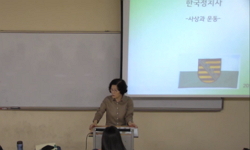논자는 본 연구에서 불타, 부파불교, 그리고 용수의 중도설을 비교하여 중도 개념의 불연속성과 연속성을 파악함으로써, 중관사상의 발생 동기 및 용수의 부파불교 법유론 비판 동기를 중도...
http://chineseinput.net/에서 pinyin(병음)방식으로 중국어를 변환할 수 있습니다.
변환된 중국어를 복사하여 사용하시면 됩니다.
- 中文 을 입력하시려면 zhongwen을 입력하시고 space를누르시면됩니다.
- 北京 을 입력하시려면 beijing을 입력하시고 space를 누르시면 됩니다.

인도불교에서 중도 개념의 불연속성과 연속성 * -불타, 부파불교 , 용수의 중도설을 중심으로 = The Continuity and Discontinuity of the Conception of Middle Way in Indian Buddhism
한글로보기https://www.riss.kr/link?id=A103039249
- 저자
- 발행기관
- 학술지명
- 권호사항
-
발행연도
2017
-
작성언어
-
-
주제어
중도개념 ; 연속성 ; 불연속성 ; 초기불교 ; 부파불교 ; 용수 ; 중관사상 ; 고락중도 ; 유무중도 ; 일이중도 ; 단상중도 ; Middle Way Conception ; Discontinuity ; Continuity ; Early Buddhism ; Schola Buddhism ; Nagarjuna ; Madhyamika Philosophy ; the Pain-Pleasure Middle Way ; the Being-Non-being Middle Way ; the Sameness-Difference Middle Way ; the Eternity-Extinction Middle Way
-
KDC
220
-
등재정보
KCI우수등재
-
자료형태
학술저널
-
수록면
27-57(31쪽)
-
KCI 피인용횟수
3
- DOI식별코드
- 제공처
- 소장기관
-
0
상세조회 -
0
다운로드
부가정보
국문 초록 (Abstract)
논자는 본 연구에서 불타, 부파불교, 그리고 용수의 중도설을 비교하여 중도 개념의 불연속성과 연속성을 파악함으로써, 중관사상의 발생 동기 및 용수의 부파불교 법유론 비판 동기를 중도 개념의 불연속성과 연속성이라는 측면에서 파악해 보고자 하였다. 본연구에서 살펴본 내용을 요약하면 다음과 같다.
불타는 중도를 고락중도, 유무중도, 일이중도, 단상중도 등의 의미로 사용하였지만, 부파불교의 논사들은 불타의 중도설을 고락중도와 단상중도를 중심으로 이해하였다.
불타, 부파불교, 그리고 용수의 중도설을 비교해보면 다음과 같은 사실을 알 수 있다. 부파불교의 법유론은 불타가 설했던 유무중도와 단상중도의 단절과 불연속성을 함축한 다. 그러나 용수의 중관사상은 불타가 설했던 유무중도 및 일이중도와 단상중도의 복원과 연속성을 함축한다.
용수는 그 밖에도 부파불교의 법유론이 불타의 중도설만이 아니라, 사성제, 연기, 삼법인 등과 같은 불타의 근본 가르침과 세간의 도덕 관습들을 모두 올바르게 설명할 수 없으며, 오직 일체법이 연기이고, 무자성, 공, 가명, 중도임을 승인할 때에만 비로소 불타의 근본 가르침과 세간의 도덕 관습이 모두 올바르게 성립할 수 있음을 논증하였다.
이와 같은 고찰로부터 중관사상의 발생 동기 및 용수의 부파불교 법유론 비판 동기를 새로운 측면에서 이해할 수 있다. 요컨대 중관사상의 발생 동기 및 부파불교 법유론에 대한 용수의 비판 동기는 불타의 중도설 복원을 통한 불타의 근본 가르침 및 세간적 도덕 관습의 복원이었던 것이다.
다국어 초록 (Multilingual Abstract)
This article tried to understand both the motive of occurrence of Madhyamika Philosophy and the motive of Nagarjuna’s critique on the Realism of Schola Buddhism, from standpoint of the continuity and discontinuity of Middle Way conception. In order ...
This article tried to understand both the motive of occurrence of Madhyamika Philosophy and the motive of Nagarjuna’s critique on the Realism of Schola Buddhism, from standpoint of the continuity and discontinuity of Middle Way conception. In order to catch out the continuity and discontinuity of the conception of Middle Way, this study compared the conception of Middle Way in Early Buddhism with that of Schola Buddhism and of Nagarjuna.
In Early Buddhism, the Middle Way was generally used in four conceptions; the Pain-Pleasure Middle Way, the Being-Non-being Middle Way, the Sameness-Difference Middle Way, and the Eternity-Extinction Middle Way. But the scholars of Schola Buddhism understood the Middle Way of the Buddha through two conceptions of the Pain-Pleasure Middle Way and the Eternity- Extinction Middle Way.
When we compared the conception of Middle Way in Early Buddhism with that of Schola Buddhism and of Nagarjuna, we can know that the Realism of Schola Buddhism implies the cutting and discontinuity of the Being-Non-being Middle Way and the Eternity-Extinction Middle Way of the Early Buddhism, but Nagarjuna’s Madhyamika Philosophy implies the restoration and continuity of the BeingNon-being Middle Way, the Sameness-Difference Middle Way, and the EternityExtinction Middle Way of Early Buddhism.
Nagarjuna proved that only when we admit that all things are the Middle Way,the basic teachings of the Buddha and the moral customs of people can be correctly established. From this, we can understand the motive of occurrence of Madhyamika Philosophy and the motive of Nagarjuna’s critique on the Realism of Schola Buddhism from a new perspective. In short, the motive of occurrence of Madhyamika Philosophy and the motive of Nagarjuna’s critique on the Realism of Schola Buddhism were the restoration of basic teachings of the Buddha and moral customs of people through the restoration of Middle Way theory.
목차 (Table of Contents)
- I. 서론 II. 불타의 중도설
- III. 부파불교의 법유론에서 중도 개념의 불연속성
- IV. 용수의 중관사상에서 중도 개념의 연속성
- V. 결론
- I. 서론 II. 불타의 중도설
- III. 부파불교의 법유론에서 중도 개념의 불연속성
- IV. 용수의 중관사상에서 중도 개념의 연속성
- V. 결론
참고문헌 (Reference)
1 남수영, "초기 불교의 중도 개념 재검토" 인도연구소 21 (21): 57-86, 2015
2 龍樹菩薩, "중론 (4권)"
3 남수영, "중관사상의 이해" 여래 2015
4 서성원, "제일의공경과 Vasubandhu" 인도철학회 (3) : 1993
5 劉宋 求那跋陀羅, "잡아함경 (50卷)"
6 櫻部建, "아비달마의철학" 민족사 2004
7 권오민, "아비달마구사론 제1권" 동국역경원 2002
8 김정근, "쁘라산나빠다 전4권" 푸른가람 2011
9 대림스님, "맛지마니까야 전4권" 초기불전연구원 2012
10 五百大阿羅漢, "대비바사론 (200권)"
1 남수영, "초기 불교의 중도 개념 재검토" 인도연구소 21 (21): 57-86, 2015
2 龍樹菩薩, "중론 (4권)"
3 남수영, "중관사상의 이해" 여래 2015
4 서성원, "제일의공경과 Vasubandhu" 인도철학회 (3) : 1993
5 劉宋 求那跋陀羅, "잡아함경 (50卷)"
6 櫻部建, "아비달마의철학" 민족사 2004
7 권오민, "아비달마구사론 제1권" 동국역경원 2002
8 김정근, "쁘라산나빠다 전4권" 푸른가람 2011
9 대림스님, "맛지마니까야 전4권" 초기불전연구원 2012
10 五百大阿羅漢, "대비바사론 (200권)"
11 尊者世親, "구사론 (30권)"
12 吉元信行, "アビダルマ思想" 法藏館 1982
13 Kamaleswar Bhattacharya, "VV; The Dialectical Method of Nāgārjuna(Vigrahavyāvartanī)" Motilal Banarsidass 1978
14 Oldenberg, Hermann, "VP 1; The Vinaya Pitakam: one of the principle of Buddhist holy scriptures in the Pali language. vol. 1: The Mahavagga" Pali text society 1997
15 L. Feer, "SN 2; Saṁyutta-Nikāya 2" PTS 1970
16 "PP; Mūla-madhyamaka-kārikās de Nāgārjuna avec la Prasannapadā Commentaire de Candrakīrti" 4 : 1913
17 J. W. De Jong, "MMK; Mūla-madhyamaka-kārikāh of Nagarjuna" Adyar Library and Research Centre 1977
18 P. Pradhan, "Akb; Abhidharmakośabhāṣyam of Vasubandhu" K. P. Jayaswal Research Institute 1975
동일학술지(권/호) 다른 논문
-
- 불교학연구회
- 김성철(Kim, Sung Chul)
- 2017
- KCI우수등재
-
인도불교사상사에서 유식사상의 연속성과 불연속성 -법과 법성의 관계를 중심으로
- 불교학연구회
- 김재권(Kim, Jae-gweon)
- 2017
- KCI우수등재
-
- 불교학연구회
- 정호영(Chung, Hoyoung)
- 2017
- KCI우수등재
-
- 불교학연구회
- 조명제(Cho, Myungje)
- 2017
- KCI우수등재
분석정보
인용정보 인용지수 설명보기
학술지 이력
| 연월일 | 이력구분 | 이력상세 | 등재구분 |
|---|---|---|---|
| 2020 | 평가예정 | 계속평가 신청대상 (등재유지) | |
| 2019-06-17 | 학회명변경 | 영문명 : Korea Association of Buddhist Studies -> Korean Association of Buddhist Studies | |
| 2019-06-11 | 학회명변경 | 영문명 : The Korean Society For Buddhist Studies -> Korea Association of Buddhist Studies | |
| 2019-06-07 | 학술지명변경 | 외국어명 : BUL GYO HAK YEONGU-Journal of Buddhist Studies -> Korea Journal of Buddhist Studies | |
| 2015-01-01 | 평가 | 우수등재학술지 선정 (계속평가) | |
| 2011-01-01 | 평가 | 등재학술지 유지 (등재유지) |  |
| 2009-01-01 | 평가 | 등재학술지 유지 (등재유지) |  |
| 2006-01-01 | 평가 | 등재학술지 선정 (등재후보2차) |  |
| 2005-01-01 | 평가 | 등재후보 1차 PASS (등재후보1차) |  |
| 2003-01-01 | 평가 | 등재후보학술지 선정 (신규평가) |  |
학술지 인용정보
| 기준연도 | WOS-KCI 통합IF(2년) | KCIF(2년) | KCIF(3년) |
|---|---|---|---|
| 2016 | 0.48 | 0.48 | 0.51 |
| KCIF(4년) | KCIF(5년) | 중심성지수(3년) | 즉시성지수 |
| 0.52 | 0.47 | 0.937 | 0.11 |





 RISS
RISS 스콜라
스콜라







